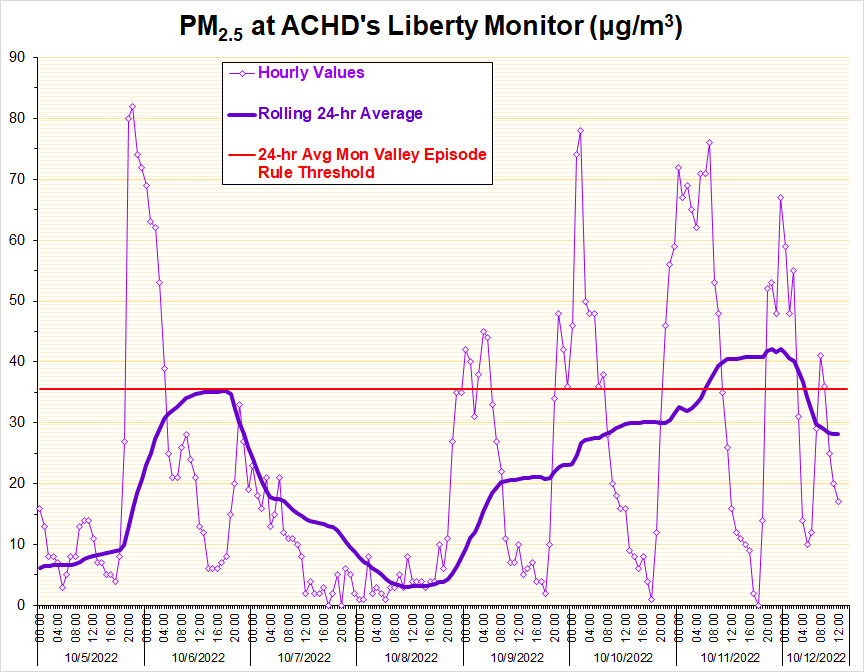Mon Valley Air Pollution Exceeded National Health Standard Tuesday, Stench Continues While ACHD Mum
- Group Against Smog & Pollution

- Oct 12, 2022
- 3 min read
Updated: Oct 13, 2022

UPDATE: Stench and elevated concentrations of H2S persisted Thursday at the Liberty air quality monitor. Another exceedance of Pennsylvania's 24-hour average standard was guaranteed early - the fifth straight day the Mon Valley was assaulted by stench. It was the eighth such exceedance in the past nine days.
If you live in or downwind of the Mon Valley, we don’t have to tell you just how bad the air quality has been over the past week, or that the stench of sulfur and rotten eggs ruined some otherwise beautiful fall days.
And we likely don’t have to tell you that the poor air quality’s assault on public health and wellbeing continues today. Users of CMU CreateLab’s crowdsourcing app SmellPGH are reporting significant industrial odors and Allegheny County Health Department (ACHD) monitor data show concentrations of hydrogen sulfide (or H2S for short) remain elevated at its air quality monitor in Liberty Borough
What we will tell you is this: The latest bout of bad air quality culminated with an exceedance Tuesday of the National Ambient Air Quality Standard (NAAQS) for fine particulate pollution (PM2.5).
Worth noting is that as of the time of publishing this story, what we’re telling you is something ACHD has NOT told the public, but more on that later.
Air quality exceeding the 24-hour PM2.5 NAAQS was not unexpected: The Department of Environmental Protection (DEP) issued a Code Orange Air Quality Action Day warning for Tuesday, which meant officials anticipated the full day to end up as an “orange” air quality index (AQI) day. An AQI in the “orange” range means air quality is “unhealthy for sensitive [populations]” like children and folks with respiratory diseases. The lowest “orange” AQI is 101 and equates to a 24-hour PM2.5 average of 35.5 ug/m3 - which is the trigger for a PM2.5 exceedance.
The final 24-hour average PM2.5 concentration at the Liberty monitor yesterday was 42.0 ug/m3, based on preliminary hourly data.
While PM2.5 levels are not expected to remain above the federal health-based standard today, H2S remains an issue for local residents. Today will mark fourth day in a row that the Mon Valley has been overwhelmed with stench and seventh such exceedance at the Liberty monitor in the past eight days.
As a reminder, while the stench was bad the past few days, H2S levels were far worse last week, when concentrations of exceeded Pennsylvania’s one-hour standard for the first time since 2015. H2S levels exceeding the state 1-hour standard have only occurred nine times in the past 20 years, according to ACHD monitor data.
But back to those PM2.5 concentrations…
In addition to the DEP calling for a Code Orange Air Quality Action Day, ACHD issued a Mon Valley Air Pollution Watch for Tuesday. These watches are part of a Mon Valley Episodic Air Pollution regulation that went into effect last year. That rule, which aims to minimize particulate pollution on days when poor weather conditions are expected to impact ambient air quality, requires major sources of pollution to minimize their emissions when a Watch turns into a Warning.
When should a Mon Valley Air Pollution Watch change to a Warning? Good question - one we’d like health department leaders to clarify. Here’s why:
The regulation states that Mon Valley Air Pollution Warning is triggered when the rolling 24-hour average for PM2.5 reaches 35.5 ug/m3. That threshold was reached as of 8 a.m. Tuesday and steadily increased throughout the day. But the rule only requires the Warning be put into effect if ACHD “has determined atmospheric conditions will continue” to contributed to a likely exceedance of the PM2.5 NAAQS.
Which brings us to the questions of the day: Why didn’t ACHD issue the warning? And had the department asked industry polluters like U.S. Steel to dial back production and take other actions to mitigate poor air quality, could the exceedance of the federal health-based standards have been avoided?
To be clear: ACHD issued the Mon Valley Watch on Monday afternoon and residents have heard nothing from them since.
“What happened yesterday was a failure of leadership and a failure of communication,” GASP Executive Director Patrick Campbell said. “Residents deserve so much more from ACHD than what they are getting. We encourage the department to take a look at the many, many odor reports made on the SmellPGH app as well as the personal stories people shared on social media yesterday.”
He continued:
“The lack of information, empathy, and action from our health department are deeply troubling.”
Editor's Note: We graphed the PM2.5 and H2S values for those who'd like to take a deeper dive into the data:


If you appreciate GASP's updates, watchdog work, educational offerings, and advocacy, please consider making a donation today. For as little as $5, you can support our work and help us keep good content on the air (see what we did there?). Click here to make a tax-deductible donation.



Comments